Stunning Northern Lights visible Friday evening in the US – here’s how to see the phenomenon
The Northern Lights could continue to dazzle the skies in the northern US states on Friday evening after an explosion of solar particles and radiation hit Earth.
A severe geomagnetic storm hit our planet yesterday, bringing the aurora as far as Key Largo, Florida, and many Americans were able to see a second round of the phenomenon.
Experts have predicted that the colorful lights will be visible Friday evening in northern states such as Montana, North Dakota and Minnesota.
The best time to see the Northern Lights is between 10 PM and 2 AM local time.
The Northern Lights were seen Thursday evening in Key Largo, Florida
They can be visible anywhere in the night sky, but are often difficult to see with the naked eye in the US.
Your smartphone’s camera can help you get a better view. Simply point your camera at the sky and watch the aurora appear on the screen.
Also known as the aurora borealis, this spectacle is a natural light show that occurs when charged particles from the Sun interact with the Earth’s magnetic field, decorating the night sky with vibrant curtains of green, pink, red, yellow, blue and violet.
Aurora is most commonly seen in the auroral zone – an area within 2,500 kilometers of the North Pole. Normally the lights can only be seen in areas such as Scandinavia, Alaska and Iceland.
But geomagnetic storms can make them appear further south.
The storm that produced Thursday’s aurora could last through Friday morning, but is expected to decrease in severity and drop to “strong” or even “moderate” levels.
Some northern states may still have a chance to see auroras Friday evening, as parts of Washington, Idaho, Montana, North Dakota, Minnesota and Wisconsin remain just within the aurora zone.
According to the National Oceanic at Atmospheric Administration, a G4 geomagnetic storm began raging in Earth’s magnetic field on Thursday, October 10 around 1:00 PM ET.
Sunspot AR3848 – a dark, fast-growing region of strong magnetic fields on the sun’s surface – produced a strong solar flare of class X1.8, which could cause power outages and strain the electrical grid.
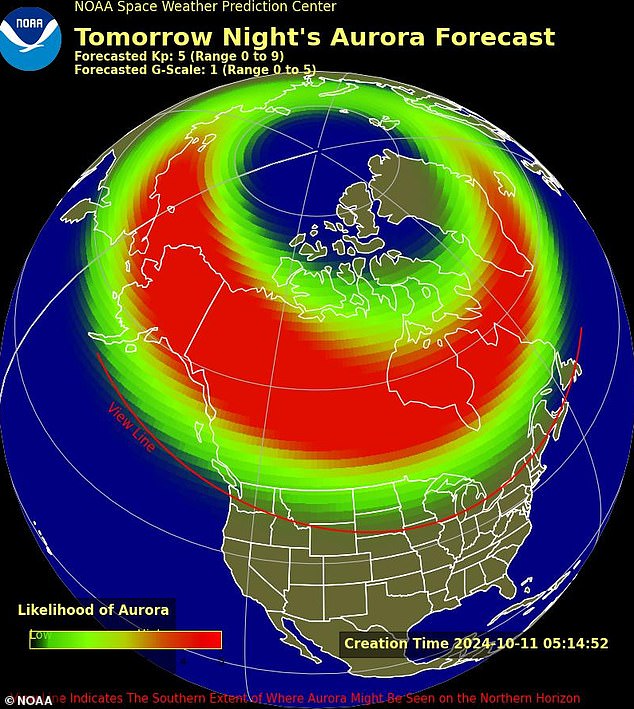
The storm may persist through Friday morning, but is expected to decrease in severity and drop to ‘strong’ or even ‘moderate’ levels
Solar flares are powerful bursts of radiation that result from the release of magnetic energy associated with sunspots. They are the largest explosive events in the solar system.
After the solar flare erupted, a second explosion of high-energy particles and solar plasma formed a direct line to Earth. This is called a coronal mass ejection or CME.
It hurtled towards us at a speed of about 1200 to 1300 kilometers per second and reached Earth on Thursday morning, causing a disruption in the magnetosphere – the region of space surrounding our planet that is dominated by its magnetic field.
This disturbance is known as a geomagnetic storm. It reached G4 strength at approximately 1:00 PM ET, according to NOAA.
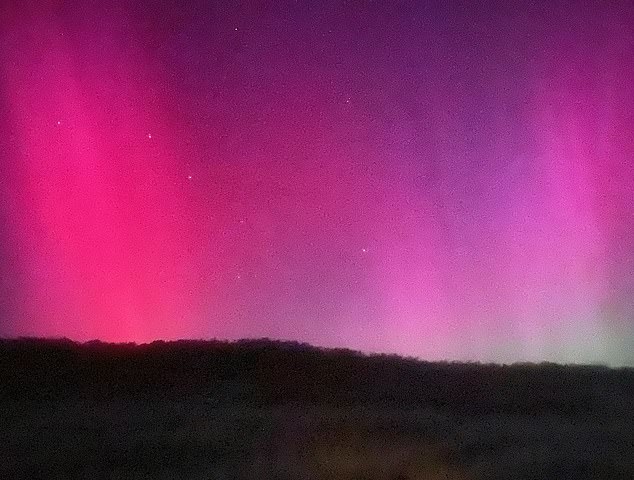
People in Salida, Colorado witnessed the pink and purple skies after the solar storm
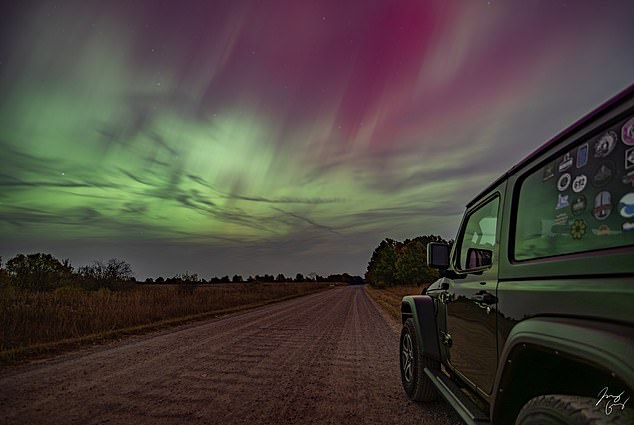
A hue of purple and green curtains of light was captured in Zimmerman, Minnesota
Geomagnetic storms are classified by severity on a scale of one to five: a G1 storm is “minor” and a G5 storm is “extreme.”
A G4 storm is considered “severe” and can produce stunning aurora images at unusually low latitudes, which happened Thursday evening in states across the US.
Posts on social media showed people in southern states such as Florida, Washington DC and Kentucky witnessing the neon pink and hazy purple skies.
Even light-polluted New York City was able to catch a glimpse of the colored spot in the night sky Thursday evening.
“I’m just shocked that it took my whole life to see it,” Gabriela Aguilar, a 37-year-old New Yorker, told The New York Times.
As she stepped onto the roof of her Harlem apartment building with her dog, she saw the sky turn pink, purple and green.
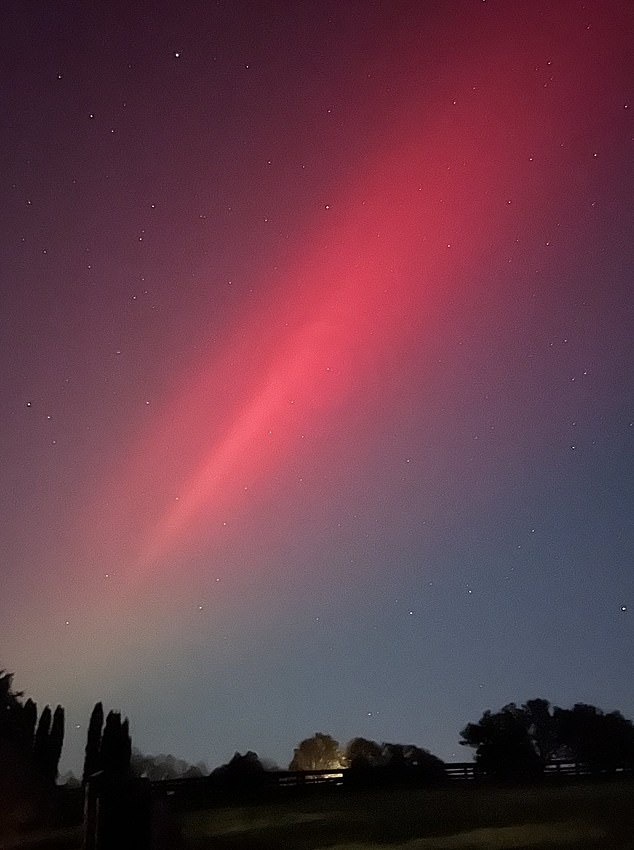
The Northern Lights were captured in Lexington, Kentucky after the massive solar storm
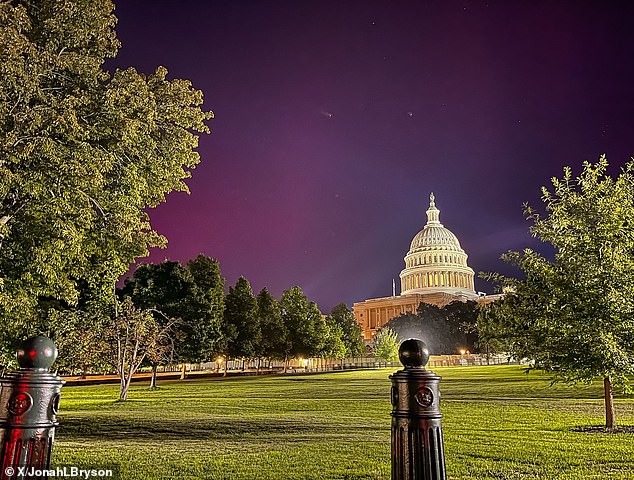
A user on
“And – of all places – to see it in New York City!” she added.
G4 storms can also disrupt power, GPS and communications systems, New York City’s Emergency Management Department said in a post on X.
“While the public is not required to take any action at this time, we always encourage everyone to stay informed through Notify NYC and have an emergency plan ready, including a Go Bag with AM radio,” NYC Emergency Management wrote on X .
The solar storm hit Earth about 14 hours after Hurricane Milton made landfall in Florida on Wednesday night, potentially impacting some recovery efforts.
In previous major solar storms, planes have been diverted due to radio signal interference. Some GPS systems lost their accuracy. Satellites were put into safe mode and successfully deorbited.
But NOAA’s Weather Prediction Center has already made contact with several government agencies involved in recovery operations.
Thousands of Americans were able to witness what could be a once-in-a-lifetime opportunity of the Northern Lights, and some may get another chance to see this rare spectacle tonight.
